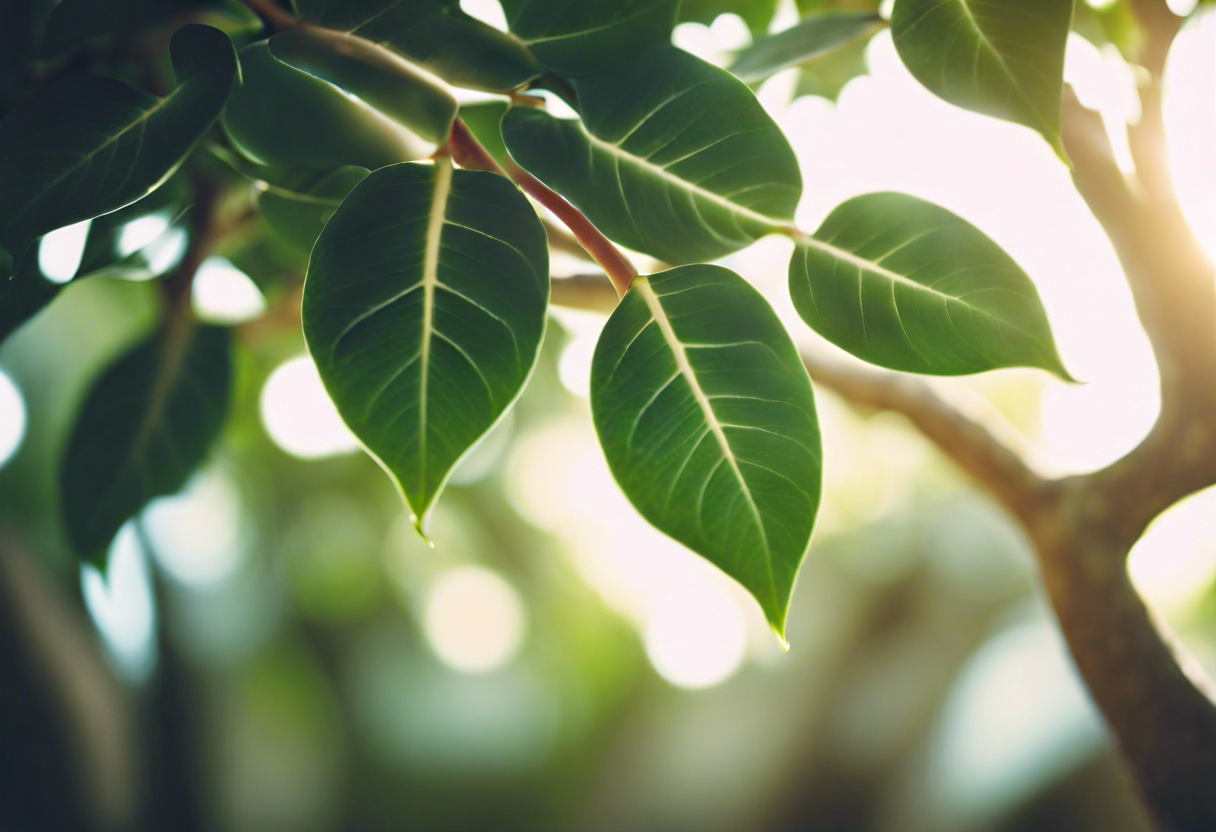The Importance of Light and Temperature for the Care of Ficus Tree
Ficus trees, known for their lush foliage and ornamental beauty, are popular choices for both indoor and outdoor landscaping. To ensure the health and vitality of your ficus tree, it is crucial to understand and provide the right amount of light and maintain suitable temperatures. These factors play a significant role in the care and well-being of your ficus tree.
Light Requirements: Ficus trees thrive in bright, indirect light. When kept indoors, they prefer a well-lit location near a window that receives filtered sunlight. Direct sunlight can scorch the leaves, causing them to turn yellow or brown. On the other hand, insufficient light can lead to stunted growth and leaf drop. If your ficus tree is not receiving enough light, consider using artificial grow lights to supplement its light requirements.
Temperature Considerations: Ficus trees prefer warm and consistent temperatures. Ideally, they thrive in temperatures ranging between 65°F and 75°F (18°C and 24°C). Avoid placing your ficus tree near drafty windows, doors, or air conditioning vents, as sudden temperature fluctuations can stress the plant. During winter months, protect your ficus tree from cold drafts by moving it away from chilly windows or using insulating curtains.
Seasonal Adjustments: While ficus trees adapt well to indoor environments, they also benefit from spending time outdoors during mild weather conditions. During spring and summer, consider moving your ficus tree outdoors to provide it with ample sunlight and fresh air. However, be cautious and gradually acclimate your tree to the outdoor conditions by placing it in a shaded area for a few hours a day, gradually increasing the exposure over time.
Monitoring Light and Temperature: Regularly monitor the light and temperature conditions around your ficus tree. Observe the foliage for any signs of stress, such as wilting or discoloration. Adjust the positioning of your tree accordingly to ensure it receives the right amount of light and is protected from extreme temperature fluctuations. Remember that each ficus tree is unique, and its light and temperature requirements may vary slightly.
Providing the appropriate amount of light and maintaining suitable temperatures are essential for the care and well-being of ficus trees. Ensure your ficus tree receives bright, indirect light, whether indoors or outdoors, and avoid exposing it to direct sunlight or excessively low light conditions. Additionally, strive to maintain a consistent temperature range that suits the tree’s preferences. By monitoring and adjusting these factors, you can create an optimal environment for your ficus tree to flourish and thrive.
The Watering Needs of Ficus Tree: A Guide to Optimal Care
Proper watering is crucial for the health and vitality of your Ficus tree. Understanding the watering needs of this popular indoor plant is essential in ensuring its optimal care and growth. In this guide, we will explore the key factors to consider when watering your Ficus tree.
One important aspect to remember is that Ficus trees prefer slightly moist soil, but they are also sensitive to overwatering. Before watering your Ficus, always check the soil moisture level. Stick your finger about an inch deep into the soil – if it feels dry at this depth, it’s time to water your tree. However, if the soil is still damp, hold off on watering to avoid waterlogging the roots.
It’s important to note that Ficus trees have different watering requirements depending on the season. During the spring and summer months when the tree is actively growing, water your Ficus tree more frequently. Aim to water it once a week, allowing the water to thoroughly soak the soil. In the winter months, when the tree enters a dormant phase, reduce the frequency of watering to every two to three weeks.
When watering your Ficus tree, it’s crucial to avoid using excessive water. Overwatering can lead to root rot and other fungal diseases, which can ultimately harm the tree’s overall health. Make sure to provide sufficient drainage by using a pot with drainage holes and well-draining soil to prevent water logging. Ensure that any excess water can freely flow out of the pot, preventing water from accumulating at the bottom.
Another important aspect of watering your Ficus tree is to observe its response to watering. If the leaves turn yellow or droop, it may indicate that you are either overwatering or underwatering the plant. Adjust your watering routine accordingly, ensuring that the soil remains slightly moist but not overly saturated.
Additionally, misting the leaves of your Ficus tree can promote humidity, which is beneficial for the plant’s overall health. The leaves of Ficus trees can gather dust, which can hinder their ability to photosynthesize properly. Misting the leaves with water can help to keep them clean and increase humidity levels around the plant.
Understanding the watering needs of your Ficus tree is essential for its optimal care. Following these guidelines on proper watering techniques, monitoring the soil moisture, and adjusting your watering routine based on the season and the tree’s response will help ensure the well-being and vitality of your Ficus tree.
Pruning and Shaping Techniques for Ficus Tree Maintenance
Pruning and shaping are essential techniques for maintaining the health and aesthetic appeal of your ficus tree. Regular pruning helps control the tree’s size, promotes branching, and removes any diseased or damaged foliage. Additionally, shaping the tree can create a desired form or design that complements your garden or indoor space. Here are some tips on pruning and shaping your ficus tree effectively.
When it comes to pruning ficus trees, it’s essential to choose the right tools. A pair of sharp bypass pruners or pruning shears is ideal for smaller branches, while loppers are suitable for thicker branches. It’s crucial to ensure that your tools are clean and sterile to prevent the spread of diseases between cuts.
Start by removing any dead, damaged, or diseased branches. These can harbor pests and prevent the tree from thriving. Make clean cuts just above the branch collar, the swollen area where the branch attaches to the trunk. Avoid leaving stubs as they can attract insects or decay.
To shape your ficus tree, consider the desired form or style you want to achieve. For indoor trees, a common choice is a standard or braided form. Select a central leader and allow it to grow taller, removing any competing branches. As your ficus grows, regularly prune and train the branches to maintain the desired shape.
For outdoor ficus trees, such as the popular Ficus benjamina, shaping can be more creative. Consider using pruning techniques like pollarding or topiary to create unique forms. However, it’s important to research the specific pruning needs of your ficus variety and consult a professional arborist if you’re unsure.
As you prune and shape your ficus tree, be mindful of its growth habits. Ficus trees are known for their rapid growth, so you may need to repeat pruning every few months to maintain the desired shape. Regular pruning also helps stimulate new growth and prevents the tree from becoming leggy or overcrowded.
After pruning, it’s advisable to apply a thin layer of horticultural pruning sealant to exposed cuts. This helps protect the tree from pests and diseases while allowing the wound to heal. However, avoid using excessive amounts of sealant, as it can inhibit healing or trap moisture against the bark.
Pruning and shaping are vital techniques for maintaining the health and appearance of your ficus tree. By following proper pruning practices and considering the growth habits of your ficus variety, you can create beautiful shapes and sizes that enhance your garden or indoor space. Regular pruning sessions will keep your ficus tree in optimal condition, ensuring its longevity and beauty for years to come.
Understanding Pests and Diseases Affecting Ficus Trees
Ficus trees are known for their lush foliage and beautiful appearance. However, they can be susceptible to various pests and diseases that can undermine their health and overall well-being. As a responsible plant owner, it is essential to be aware of the common issues that can affect ficus trees and take necessary measures to prevent and control them.
One of the most common pests that infest ficus trees is the spider mite. These tiny arachnids suck the sap from the leaves, leading to discoloration and a weakened plant. To prevent spider mites, regularly inspect the leaves for any signs of webbing or small yellow spots. If detected, immediately isolate the infected plant and use an organic insecticidal soap or neem oil to eliminate the pests. Additionally, maintaining proper humidity levels can discourage spider mites from infesting the ficus tree.
Mealybugs are another common nuisance for ficus trees. These small, white, cottony insects also feed on the sap and can cause leaf drop and stunted growth. To control mealybugs, a simple solution of water and mild soap can be applied to the affected areas. However, severe infestations may require the use of a commercial insecticide. Regularly inspecting the underside of the leaves and pruning infested branches can prevent the spread of mealybugs.
Scale insects are yet another pesky problem for ficus trees. These small, immobile insects attach themselves to the stems and leaves and feed on the plant’s sap. They can be identified by their waxy, shell-like covering. To eliminate scale insects, gently scrape them off with a soft brush or cotton swab dipped in alcohol. Regularly monitoring your ficus tree for signs of scale insects and taking immediate action is vital to prevent further damage.
Fungal infections such as leaf spot and crown gall can also affect ficus trees. Leaf spot appears as brown spots on the leaves, while crown gall causes abnormal swelling on the branches or trunk. To prevent these infections, avoid overwatering the tree and ensure proper drainage. Pruning infected branches and removing fallen leaves can also help control the spread of fungi. In severe cases, systemic fungicides may be necessary, but it is best to consult a professional for proper diagnosis and treatment.
Proper care and maintenance can go a long way in preventing and controlling pests and diseases in ficus trees. Regularly inspecting the plants, maintaining proper humidity levels, and providing adequate air circulation can help create an unfavorable environment for pests and fungi. Additionally, practicing good sanitation by removing fallen leaves and regularly cleaning the plant’s surroundings can further prevent infestations.
Ficus trees are susceptible to various pests and diseases, including spider mites, mealybugs, scale insects, and fungal infections. It is crucial to be vigilant and take necessary measures to prevent and control these issues. With proper care and regular monitoring, you can ensure the health and well-being of your ficus tree, allowing it to thrive and beautify your indoor or outdoor space.
Tips for Fertilizing and Nutritional Care of Ficus Tree
Ficus trees are popular indoor and outdoor plants due to their attractive foliage and low maintenance requirements. To keep your ficus tree healthy and thriving, proper fertilization and nutritional care are essential. Here are some tips to help you provide the best care for your ficus tree’s nutrient needs.
Choose the Right Fertilizer: When it comes to fertilizing your ficus tree, selecting the right fertilizer is crucial. Look for a well-balanced, water-soluble fertilizer specifically formulated for houseplants or trees. These fertilizers typically contain a balanced ratio of nitrogen (N), phosphorus (P), and potassium (K), along with essential micronutrients.
Frequency of Fertilization: Ficus trees have moderate fertilization requirements. During the growing season, which usually spans from spring to early fall, fertilize your ficus tree every four to six weeks. In winter, when the tree’s growth slows down, reduce the frequency to once every two months.
Follow Dilution Guidelines: Always follow the dilution guidelines mentioned on the fertilizer packaging. Over-fertilizing can harm your ficus tree, leading to nutrient imbalances and potential leaf burn. Measure and mix the fertilizer with water as instructed, and avoid applying it directly to dry soil or foliage.
Apply Fertilizer to Moist Soil: Fertilizers are best applied to damp soil to prevent root burn. Before applying the fertilizer, water the ficus tree thoroughly. Once the soil is moist, apply the diluted fertilizer evenly over the soil surface. Avoid getting the fertilizer on the leaves as this can cause damage.
Consider Seasonal Adjustments: As seasons change, your ficus tree’s nutritional needs may vary. During periods of active growth, increase the frequency and amount of fertilization. Conversely, when the tree is in its dormant phase, reduce the fertilization to avoid nutrient buildup in the soil.
Monitor Leaf Color and Growth: The color and growth of your ficus tree are reliable indicators of its nutritional health. If the leaves appear pale or show signs of stunted growth, it may be a sign of nutrient deficiency. In such cases, adjust your fertilization regime or consider adding a slow-release fertilizer to provide a steady supply of nutrients over time.
Prevent Nutrient Leaching: Ficus trees are susceptible to nutrient leaching, especially when grown in containers. To prevent excessive nutrient loss, use a well-draining potting mix and avoid overwatering. Regularly flush out any accumulated salts in the soil by thoroughly watering until water drains from the bottom of the pot.
By following these tips for fertilizing and nutritional care, you can ensure that your ficus tree receives the essential nutrients it needs to thrive. Remember to monitor your tree’s response to fertilization and make adjustments as necessary. With proper care, your ficus tree will reward you with lush green foliage and a vibrant presence in your home or garden.
Conclusion
Caring for a ficus tree requires attention to several key factors. Light and temperature play vital roles in the overall health and growth of ficus trees. Providing them with the right amount of bright, indirect light and maintaining a consistent temperature between 60-75°F (15-24°C) will ensure their proper development.
Watering ficus trees can be a delicate balancing act. Understanding their watering needs is crucial to prevent overwatering or underwatering. Ficus trees prefer to be kept evenly moist but not waterlogged. It is important to water the tree thoroughly when the top inch of soil feels dry and allow any excess water to drain away.
Pruning and shaping can greatly enhance the aesthetics of ficus trees while also promoting healthier growth. Regular pruning helps to control the size and shape of the tree, removing any dead or diseased branches. Additionally, using proper techniques such as making clean cuts and avoiding excessive pruning will minimize stress on the tree.
Despite their hardy nature, ficus trees are susceptible to certain pests and diseases. Common problems include scale insects, mealybugs, and fungal diseases. Regular inspections and prompt treatment using natural or chemical controls will help keep these issues under control and prevent further damage.
Fertilizing ficus trees is essential for their nutritional care. Using a balanced, slow-release fertilizer during the growing season can provide the necessary nutrients for healthy growth. However, it is important to avoid over-fertilizing, as this can lead to salt buildup and root damage. Following a proper fertilization schedule and using the correct amounts will ensure optimal nutrition for ficus trees.
Caring for ficus trees requires a combination of knowledge and attentive care. By understanding their light and temperature requirements, watering needs, pruning techniques, pest and disease control measures, as well as proper fertilization, enthusiasts can cultivate healthy and thriving ficus trees. With a little bit of effort and regular maintenance, these beautiful plants can bring joy and greenery into any indoor or outdoor space.


